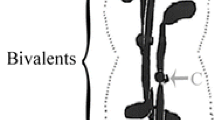Summary
-
1.
In the primary spermatocytes of the mantid Humbertiella indica the separation of the centers during late prophase is accompanied by corresponding movements of the nuclear membrane. Center and membrane thus remain in close juxtaposition suggesting that some form of attraction operates between them.
-
2.
Interpolar distances are subject to a series of changes definitely associated with the successive mitotic phases. At the initiation of spindle formation the distance between the centers is large; it decreases sharply until metaphase; then remains constant until mid anaphase; and progressively increases to an extreme degree during late anaphase and early telophase.
-
3.
At first metaphase the autosomal bivalents orient in a typical equatorial plate, but the X chromosome lies out in the cytoplasm, spatially separated from the spindle body by a wall of mitochondria.
-
4.
Expulsion of the X chromosome from the spindle is correlated with a delay in its kinetochore-center interaction.
-
5.
The anaphase movement of the autosomes is associated with a progressive shortening of the chromosomal fibers during the entire anaphase, accompanied during late anaphase by an elongation of the spindle body. But in the case of the X chromosome shortening of the chromosomal fiber occurs only during late anaphase.
-
6.
Subsidiary conclusions on the cytoplasmic origin of the chromosomal fiber of the X, the relation of the bouquet stage to the double polarization of late prophase, the non-chiasmate structure of the autosomal bivalents, and the absence of the premetaphase stretch stage are recorded.
Similar content being viewed by others
Literature Cited
Fischer, I.: Grundriß der Gewebezüchtung. Jena: Gustav Fischer, 1942.
Hughes-Schrader, S.: Meiosis without chiasmata, — in diploid and tetraploid spermatocytes of the mantid Callimantis antillarum Saussure. J. Morph. 73 (1943 a).
Hughes-Schrader, S.: Polarization, kinetochore movements, and bivalent structure in the meiosis of male mantids. Biol. Bull. (Am.) 85 (1943 b).
Michel, K.: Zeiß Nachrichten 4 (1943).
Oguma, K.: Karyotype and phylogeny of mantids. La Kromosoma 1 (1946).
Östergren, G.: Transverse equilibria on the spindle. Bot. Notis. 1945 a.
Östergren, G.: Equilibrium of trivalents and the mechanism of chromosome movements. Hereditas 31 (1945 b).
Ris, H.: A quantitative study of anaphase movement in the aphid Tamalia. Biol. Bull. (Am.) 85 (1943).
Schrader, F.: The elimination of chromosomes in the meiotic divisions of Brachystethus rubromaculatus Dallas. Biol. Bull. (Am.) 90 (1946 a).
Schrader, F.: Autosomal elimination and preferential segregation in the harlequin lobe of certain Discocephalini (Hemiptera). Biol. Bull. (Am.) 90 (1946 b).
Schrader, F.: Data contributing to an analysis of metaphase mechanics. Chromosoma 3 (1947).
White, M. J. D.: A new and anomalous type of meiosis in a mantid, Callimantis antillarum Saussure. Proc. roy. Soc. (London), Ser. B 125 (1938).
Author information
Authors and Affiliations
Rights and permissions
About this article
Cite this article
Hughes-Schrader, S. Expulsion of the sex chromosome from the spindle in spermatocytes of a mantid. Chromosoma 3, 257–270 (1950). https://doi.org/10.1007/BF00319479
Received:
Issue Date:
DOI: https://doi.org/10.1007/BF00319479




